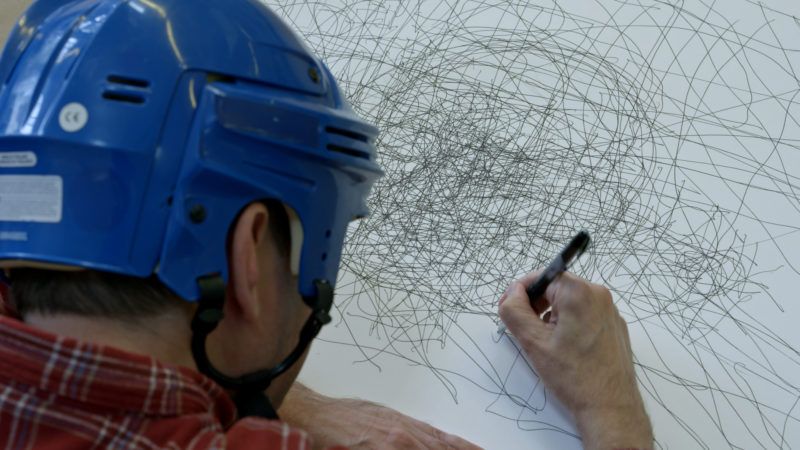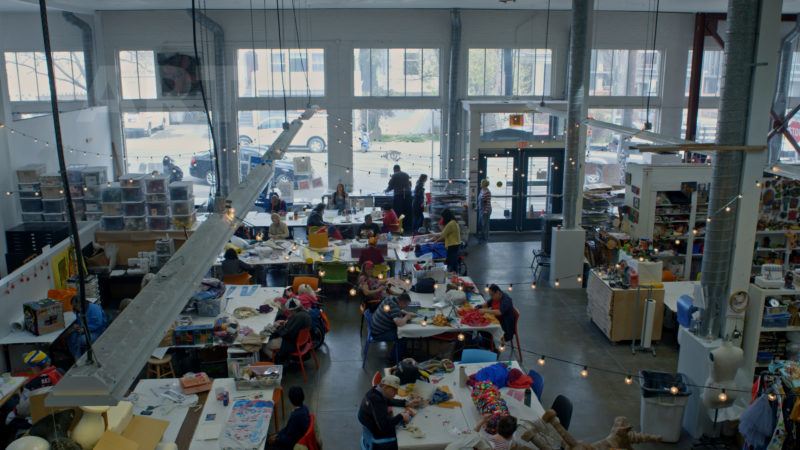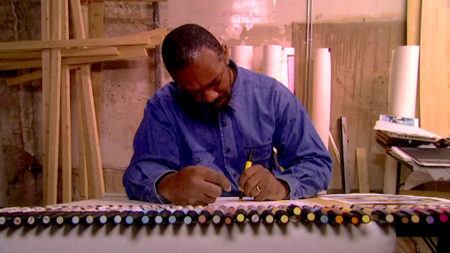Teaching with Contemporary Art
“Tell Us Your Story”: Lessons from Creative Growth

Production still from the Art in the Twenty-First Century Season 9 episode, “San Francisco Bay Area.” © Art21, Inc. 2018.
When art is a language that everyone can speak and hear, and through it be heard and understood, we grow as humans. Using the language of art, we can share our loves, fears, and needs, and we can connect with one another. At times, being an art teacher is a blessing. Sometimes when I tell folks that I’m an art teacher, they say, “Ooooh! That’s amazing.” What they don’t realize is that many people fear walking into an art room. As an art educator, I want to provide space, materials, time, and freedom to create. I want to work with anyone willing to share their voice through art.
I teach in a public high school in Seattle, Washington. My class sizes range from 27 to 36 students, from freshman to seniors. Currently, I teach five online classes. Teaching online during the pandemic presented a tremendous shift from teaching in a physical space filled with art supplies. Within a classroom, it can be tough to connect with students who are afraid to share their voices, but in that room a teacher can sense frustrations, support vulnerabilities, and propose ideas. For online classes, Seattle Public Schools doesn’t require students to turn on their cameras, so I have never seen many of these students. Some have never made any art, shared their thoughts, or even answered the question, “How are you?”
At the beginning of the school year, students rarely turned on their cameras, and eventually no one did, and some stopped turning on their microphones. A few shared with me that they have anxiety about hearing themselves speak. As an educator, I strive to adapt to classroom conditions, but in the online environment, I felt I was falling short for not adapting faster and for not having the technical expertise I needed immediately. Roughly 80 percent of my 158 students engaged at the most basic level: they may write in the chat, turn in their projects to Schoology (our learning management system), and sometimes share their art with others and give a presentation. But I despair about the 20 percent that I haven’t been able to reach. Still, I try to understand the limitations of online teaching and carry on.
At the end of the first semester, I felt some success. I made a choice board in Schoology: students could create something from Option A, which included 2D, 3D, video, digital, and traditional art (some students even baked cupcakes with a theme), or they could respond to prompts from Option B, which offered videos, podcasts, and essays from people like the writer/comic Tessa Hulls, the poet Amanda Gorman, and the writer Gabby Rivera. These were the prompts to consider:
- Give a brief review or breakdown of the piece.
- What did you learn? What insights did you gain?
- What surprised you?
- What emotions were stirred? (Check the mood meter, if you need a list.)
- What are some big themes or takeaways from the piece?
- What stands out as a powerful message from this piece?
- Discuss whether you agree or disagree with the piece. What are your opinions about the piece?
- Share a phrase or sentence—quote something from the piece—and why you picked it

Production still from the Art in the Twenty-First Century Season 9 episode, “San Francisco Bay Area.” © Art21, Inc. 2018.
Together in class, online, we watched a couple of the videos: one made by Art21 featuring Creative Growth Art Center and one about Gabby Rivera. Payton, a sophomore who I have only seen a few times, wrote a two-and-half-page essay, using the prompts above. She wrote lovingly about three Creative Growth artists—Dan Miller, Judith Scott, and William Scott—in a story about understanding herself.
After watching that film, I could truly see how all those people are really the same as us. They want to help the world and share their voices and experiences, but they just don’t have the same communication tools we do… Seeing the powerful work of those artists—and the meanings and passion they take straight from their most precious values and beliefs and love, and putting all of their being into their pieces—was just so breathtaking. I think realizing their brilliance and resilience is one of the most eye-opening things that has happened to me in a very long time—and trust me, I’m always yearning to learn about everything, especially people’s different experiences.
When Payton writes about yearning to learn about everything, she is getting to the heart of Creative Growth. Tom di Maria, the director of the center, states that Creative Growth “is about artistic expression as a form of self empowerment as a form of aesthetic development as a form of saying, ‘This is who I am in the world.’” As an educator and creative soul, this is what I want to hold in my heart. This is what I hope everybody can realize.

Production still from the Art in the Twenty-First Century Season 9 episode, “San Francisco Bay Area.” © Art21, Inc. 2018.
This school year has not been the most consistent or connected, and we are about to embark on a path to move classes back into the school building. Some students may choose to opt out and stay with remote learning. Stress is the loose thread tying everything together. Teaching and learning with art online is still possible, and a hybrid setting may even nurture future adaptations. As long as yearning and curiosity are present, we can grow creatively and make worlds together.



